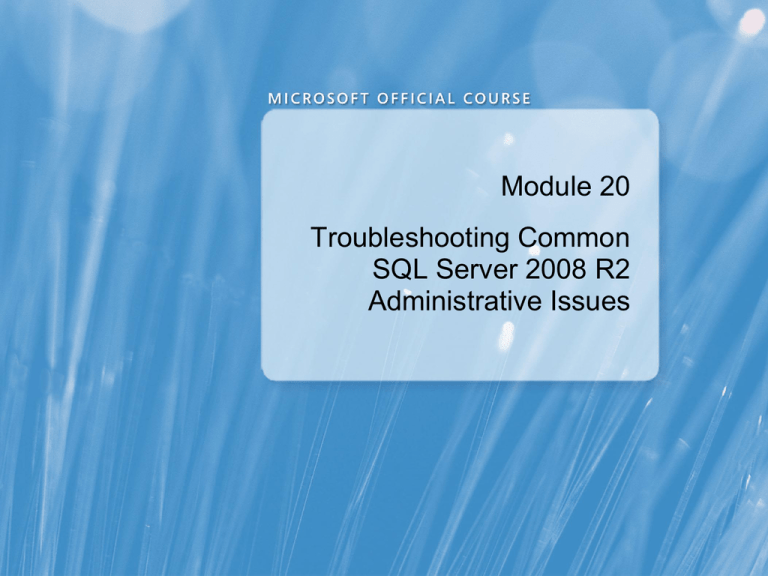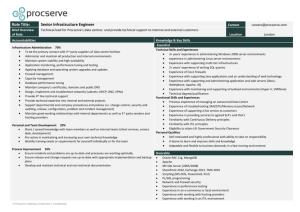6231B_20
advertisement

Module 20 Troubleshooting Common SQL Server 2008 R2 Administrative Issues Module Overview • SQL Server Troubleshooting Methodology • Resolving Service-related Issues • Resolving Concurrency Issues • Resolving Login and Connectivity Issues Lesson 1: SQL Server Troubleshooting Methodology • Discussion: Characteristics of Good Trouble-shooters • Applying a Troubleshooting Methodology Discussion: Characteristics of Good Trouble-shooters • What characteristics have you observed in people that you consider to be good trouble-shooters? • What characteristics do you notice in people that are poor trouble-shooters? Applying a Troubleshooting Methodology • Investigate Clearly define the issue as perceived by the user What works? What doesn't work? Did it ever work? When did it last work? What else changed? How would you know if it is resolved? • Analyze Brainstorm all potential causes Which potential causes are likely? How could they be tested for and eliminated? • Implement Eliminate potential causes in descending order of likelihood • Validate Ensure that the issue really is resolved Lesson 2: Resolving Service-related Issues • Troubleshooting Service-related Issues • SQL Server Error Log • Windows Event Logs • Demonstration 2A: Troubleshooting Service-related Issues Troubleshooting Service-related Issues Typical issue: One or more SQL Server services will not start or cannot be accessed. • Check Windows and SQL error logs • If SQL Server can be started but not accessed: Check for network related issues Try to access SQL Server via the DAC • If SQL Server will not start: Check the Windows system log Check master and model databases for corruption Check that the paths to tempdb files are accessible Try to start the service from the command prompt SQL Server Error Log • Log File Viewer cannot be used when the instance is not started Use editor to open the current log file and review it Also review previous logs as the problem might have occurred before Windows Event Logs • System Log to review Windows related information • Application Log to find application related messages Demonstration 2A: Troubleshooting Service-related Issues • In this demonstration you will see how to troubleshoot a service-related issue. Lesson 3: Resolving Concurrency Issues • Core Concurrency Concepts • Troubleshooting Blocking • Demonstration 3A: Troubleshooting Blocking • Troubleshooting Deadlocks • Demonstration 3B: Troubleshooting Deadlocks Core Concurrency Concepts • SQL Server has to ensure ACID properties of transactions • Locking is the mechanism used to synchronize access by multiple users to the same data at the same time • Isolation levels define the type and length of locks used • Two main types of lock: Shared locks – Allow others to read but not write Exclusive locks – Stop others from reading or writing • Locks prevent update conflicts Locking ensures that transactions are serialized Locking is automatic Locks enable safe concurrent access to data Troubleshooting Blocking Typical issue: Applications don't seem to be doing anything but also aren't returning errors. • Processes are blocked when they wait for locked resources Normal behavior, essential for the system Resource is shown as waiting to acquire a lock Only a problem when the wait duration is lengthy • Monitor long lasting blocking scenarios SQL Server Activity Monitor Dynamic Management Views SQL Server Data Collector Demonstration 3A: Troubleshooting Blocking • In this demonstration, you will see how to troubleshoot a blocking issue Troubleshooting Deadlocks Typical issue: Deadlock errors (1205 errors) are returned. • Deadlocks are circular blocking scenarios • SQL Server automatically detects deadlocks Rolls back transactions with error 1205 on deadlock victim • Monitor using deadlock occurrences with Profiler and SQL Trace Granted Lock Task 1 Waiting Lock Resource 1 Waiting Lock Task 2 Granted Lock Resource 2 Demonstration 3B: Troubleshooting Deadlocks • In this demonstration, you will see: How to trace a deadlock using SQL Server Profiler How to extract deadlock events from SQL Server Profiler How to open deadlock files using SSMS Lesson 4: Resolving Login and Connectivity Issues • Troubleshooting Connectivity Issues • Troubleshooting Login Failures Troubleshooting Connectivity Issues Typical issue: Cannot connect to SQL Server. • Try to access using Shared Memory on the server If no access via Shared Memory, troubleshoot the login and the service • Test the network connectivity Can the server name be resolved? Can the network and the server be reached? Is the Browser Service Running for Named Instances that are not using fixed ports? Is the client configured to use the right protocol and settings? Is a firewall blocking connectivity? Troubleshooting Login Failures Typical issue: Cannot logon to SQL Server. • Windows Logins Is the Domain Controller available? Can SQL Server communicate with the Domain Controller? • SQL Server Logins Is SQL Server configured for Mixed Mode? Is the password correct? Is the login locked or is there a requirement to change password? • General Considerations Is the login enabled and does it have CONNECT permission? Is the default/requested database available and access permitted? Lab 20: Troubleshooting Common Issues • Exercises 1 – 5: Troubleshoot and resolve SQL Server administrative issues Logon information Virtual machine 623XB-MIA-SQL User name AdventureWorks\Administrator Password Pa$$w0rd Estimated time: 45 minutes Lab Scenario You need to be able to resolve common issues with SQL Server processes and services at the time they are occurring. There are five exercises that create issues. You should attempt to troubleshoot and resolve as many of these issues as possible. Lab Review • What advantage would monitoring for deadlock errors using SQL Trace have over using SQL Server Profiler? • What is the first place you should look for information when the SQL Server service will not start? Module Review and Takeaways • Review Questions • Best Practices





